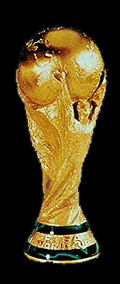



| Historical Background The World Cup is the world's most popular single sporting event. The World Cup  originates from the Olympic games of the 20th century. In 1920, at the Antwerp Olympic games, 22 nations from South America, Asia and Africa participated in football matches. In the 1928 the Olympic games held in Amsterdam gathered 17 nations participated in football matches. originates from the Olympic games of the 20th century. In 1920, at the Antwerp Olympic games, 22 nations from South America, Asia and Africa participated in football matches. In the 1928 the Olympic games held in Amsterdam gathered 17 nations participated in football matches. On May 26, 1920, FIFA(Federation Internationale de Football Association) announced its plans to organize football competitions; this was the birth of the World Cup. During the FIFA General Congress of June 1929, FIFA president Jules Rimet passed a vote to create the World Cup "We will open the World Cup match to all member nations to send their teams to participate". Consequently, the first World Cup match was held in 1930 in Uruguay. Unfortunately, it was held during a transition period between World War I and the world economic crisis of 1929 and not one European country applied to join in the event. Nevertheless, Mr. Jules Rimet persuaded four European countries to participate and a total of 13 countries gathered together to play in the first World Cup. The matches were held between July 13-July 30, 1930 in three football stadiums in Uruguay. The World Cup is held every four years in between the Olympic games. Due to World War II, there was a 12-year gap between the 1938 World Cup in France and the 1950 World Cup in Brazil. Origin of the World Cup trophy There have actually been two World Cup trophies made during the lifetime of the games.  The original trophy was made by a French sculptor, Abel LaFleur, in gold. This sculpture was of the lady of Victory stretching both arms out to support an eight-angled cup on a marble-like base. This trophy was called the "Jules Rimet Cup", in honor of the founder of the World Cup event. During the course of three World Cup events (1930, 1934 and 1938) which were held before the Second World War, the name changed to simply the 'World Cup'. The original trophy was made by a French sculptor, Abel LaFleur, in gold. This sculpture was of the lady of Victory stretching both arms out to support an eight-angled cup on a marble-like base. This trophy was called the "Jules Rimet Cup", in honor of the founder of the World Cup event. During the course of three World Cup events (1930, 1934 and 1938) which were held before the Second World War, the name changed to simply the 'World Cup'.This trophy has had an interesting history. During the Second World War, it has hidden from the Germans under a bed in an Italian home. After surviving World War II, this trophy was stolen during a public exposition just before the 1966 England World Cup. Fortunately, the trophy was later found in a trash container by a dog called "Pickles". The Brazilian team won the trophy permanently in 1970, as the reward for being the only team ever to have won three World Cups. Unfortunately, the trophy was stolen a second time in 1983 in Brazil and never recovered. It is assumed that the thieves melted down the trophy. The Brazil Football Association now has a duplicate of the trophy. A second trophy was selected in 1974 by FIFA. There were 53 designs to choose from. The Italian sculptor, Silvio Gazazniga won the commission. He designed this trophy in 18 carat gold. The sculptor explained that "players are supporting the earth from the bottom on a circle form, which represents the emotional moment of winning the game." The trophy is 36 cm (14 inch) high, weighs 4,970 g (11 lb) and permanently belongs to FIFA. A replica is presented to the winner. |